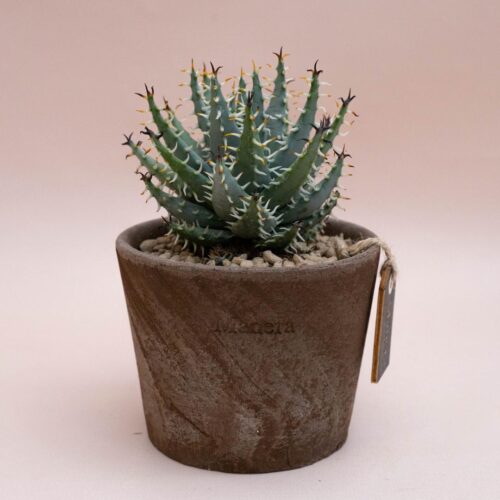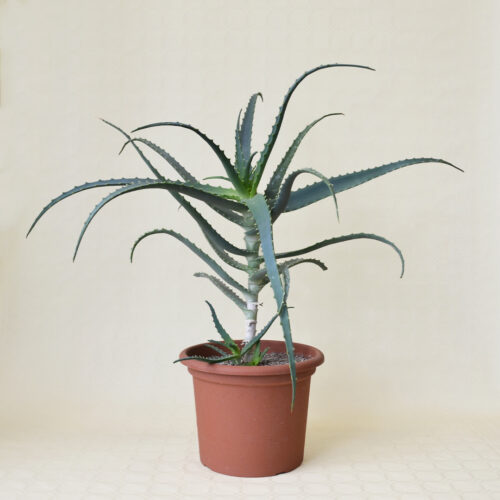Aloe arborescens: benefits and cultivation of the plant
Aloe arborescens is a succulent plant belonging to the Asphodelaceae family, known for its remarkable therapeutic properties and versatility. It is highly valued in the fields of natural medicine and cosmetics, where it is used in various forms, from gels to juices. The growing interest in natural remedies has led to a rediscovery of historically used species, with Aloe arborescens standing out for its unique characteristics and numerous benefits.
Importance and popularity of aloe
In recent years, Aloe arborescens has gained increasing recognition, both among gardening enthusiasts and those seeking natural remedies for well-being. Its ability to adapt to different environments and its ease of cultivation make it an excellent choice for those looking to enrich their homes with useful plants. It is often used to support the immune system and for its anti-inflammatory properties. Additionally, Italian folk culture has long celebrated Aloe as an effective remedy for a variety of skin and digestive issues.
Aloe arborescens is not only praised for its therapeutic effects; it also represents an important component of the cultural and culinary traditions of many regions. In Italy, for example, its leaves are used not only to create a wide range of natural remedies but also in traditional dishes that highlight its flavor. This plant, with its long history, holds a place of honor not only in gardens but also in kitchens. Some traditional recipes include the addition of Aloe juice as an ingredient to flavor fresh dishes, adding a touch of novelty and health. Its beneficial properties are also found in detox drinks, whose popularity is growing among those aspiring to a healthy lifestyle. Exploring the culinary potential of Aloe arborescens can add a new dimension to its everyday use.
Botanical description
Aloe arborescens is classified as follows:
- Family: Asphodelaceae
- Genus: Aloe
- Species: Aloe arborescens
This succulent tree is characterized by a branched structure, which can reach up to three meters in height.
Physical appearance
The leaves of Aloe arborescens are lance-shaped, deep green, and thick, covered with a waxy coating. Their shape, typical of succulent plants, allows for efficient water storage. During the flowering period, which usually occurs in winter or early spring, tubular flowers in red, orange, or yellow develop, creating a striking contrast with the foliage.
Natural Habitat and Geographic Distribution
Native to the tropical and subtropical regions of Africa, this plant has been introduced and cultivated in various parts of the world, including Italy. It prefers well-drained soil and sunny exposure, making it suitable for hot and arid climates. However, Aloe arborescens is resilient, adapting well to more variable growing conditions, making it one of the most common plants in home care and decoration.
Properties and health benefits
Aloe arborescens is known not only for its beauty but also for the numerous health benefits it offers. It is traditionally used to promote wound healing and relieve burns. Its chemical composition includes a variety of nutrients, such as vitamins, minerals, amino acids, and antioxidants, which contribute to its beneficial effects on the skin and digestive system.
Chemical composition
Among the active compounds that characterize Aloe arborescens is acemannan, a substance essential for immune system activation. Additionally, vitamins like C and E, along with certain minerals, work synergistically to support overall health. These elements make Aloe arborescens a valuable ally in combating inflammation and infections.
The presence of digestive enzymes is particularly interesting, enriching the plant’s nutritional profile and improving nutrient absorption while promoting healthy digestion. Aloe arborescens also contains substances with antibacterial and antiviral properties, capable of supporting the body’s natural defenses. Recent scientific studies have shown that regular consumption of Aloe-based products can contribute to overall well-being, reducing inflammation and digestive disorders. These findings are fueling growing interest in integrating Aloe arborescens into specific diets, bridging ancient traditions and modern health discoveries.
Use in natural remedies and cosmetics
It is no surprise that Aloe arborescens is frequently used in cosmetic products and natural remedies. Aloe-based gels are commonly applied to hydrate the skin, treat acne, and reduce irritations. In the food industry, Aloe juice is consumed as a supplement to improve digestion and promote general well-being.
Optimal Growing Conditions
To thrive, Aloe arborescens requires direct sunlight for at least a few hours a day. It prefers sandy, well-drained soil to avoid potentially harmful water stagnation. It is advisable to use a pot with drainage holes to ensure effective water drainage.
The cultivation of Aloe arborescens also lends itself to innovative techniques like hydroponics, allowing it to thrive without soil, reducing the risk of root diseases and optimizing water use. This approach is particularly suitable for those living in small spaces. Additionally, Aloe arborescens is an excellent example of how plants can contribute to domestic sustainability; its resistance to pests reduces the need for chemical pesticides, enabling eco-friendly cultivation. For gardening enthusiasts, exploring these new cultivation methods stimulates creativity and offers the opportunity to deepen plant knowledge, enhancing the gardening experience.
Care and maintenance recommendations
Caring for Aloe arborescens is relatively simple. It is recommended to water the plant only when the soil is completely dry, avoiding overwatering. During the summer months, it can be fertilized with a low-nitrogen fertilizer to promote healthy growth.
Tips for plant propagation
Propagation of Aloe arborescens can easily be done through cuttings. Mature plants produce offsets that can be separated and replanted. It is essential to let the cuttings dry for a few days before planting them in the soil to avoid the risk of rot.
Quick Questions
- Where to place Aloe arborescens? It thrives in sunny positions; a bright windowsill or a spot with direct light is ideal.
- When does it flower? Flowering usually occurs in winter and early spring, producing vibrant-colored flowers.
- How to care for it? It requires well-drained soil, sun exposure, and sparse watering, avoiding water stagnation.
- How much to water? Water only when the top layer of soil is dry, typically every two to three weeks.
- How to grow it in a pot? Use a pot with drainage holes, choose a good substrate, and ensure proper light exposure.
- How to propagate it? The plant propagates easily through cuttings or offsets that can be planted directly in the soil.
Conclusion
Having Aloe arborescens at home does not simply mean owning an ornamental plant but also having a valuable ally for health and well-being. Thanks to its healing properties and ease of cultivation, it represents an excellent choice for those looking to integrate natural remedies into their daily lives. We encourage you to consider Aloe as an integral part of your personal care routine, taking advantage of its unique and beneficial characteristics.
The versatility and benefits of Aloe arborescens make this plant one of the most beloved in the realm of medicinal and ornamental plants. With the right attention and care, it can become a precious source of well-being and harmony in your home.









